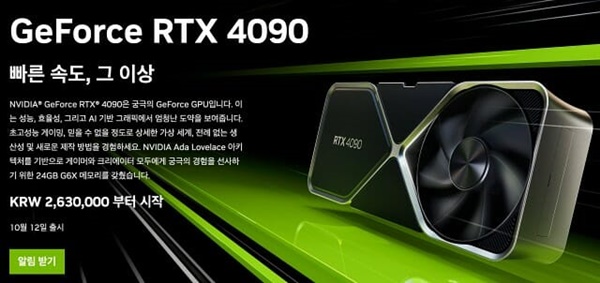In the 1980s, the Japanese economy was booming. There were many fields that were catching up with the United States, the most powerful country, and the Japanese people were full of confidence to that extent. In the United States, there was an argument that 'the United States should learn from Japan'. But in fact, it was due to the huge bubble in real estate prices along with the appreciation of the yen due to the Plaza Accord.
Japan's 'lost 30 years' was the result of the Japanese government and people not properly acknowledging the bubble of the 1980s. Japan did not recognize that it was a bubble and that it had to change with the times and build skills. It is painful, but progress comes only when we acknowledge the bubble and try to innovate.
On September 21st, Nvidia announced the RTX 40 series of GPUs for PC. This is a new product released two years after the RTX 30 series was unveiled in September 2020.
The RTX 40 series features up to 76 billion transistors and 18,000 CUDA cores. The maximum computational performance is 90 teraflops (TFlops), which is up to 2 times higher than the previous generation product. Game performance is improved by 25% and ray tracing performance is improved up to 3 times.
Two Nvidia Encoders (NVENCs), a video processing engine, are also installed, reducing processing time by half. AV1 encoding, an open source video codec, is also supported. DLSS (Deep Learning Supersampling) function converts a low-resolution screen to a high-resolution one. DLSS 3 will be supported in 35 major games including 'Microsoft Flight Simulator' and 'Cyberpunk 2077'.
The price of the top-tier GeForce RTX 4090 (G6X 24GB memory) is around 2,630,000 KRW. The RTX 3090 was $1,499, but the factory price went up by $100, and the Korean price went up even more because of the won/dollar exchange rate. The RTX 4080 will be released in 16GB/12GB memory models, and the price of the 16GB model is 1,920,000 KRW and the 12GB model price is about 1,400,000 KRW.
The problem is the price. Over the past two years, GPU performance has improved. However, there is a controversy that the price of the graphics card is too high compared to the improved performance.
The RTX 3080 MSRP was $699, while the 4080 16GB was $1,199. There are also claims that the RTX 4080 16GB and 12GB use a completely different chip rather than a simple memory difference in product classification.
As a result, before the announcement of Nvidia's next-generation GPU, the previous generation of used graphics cards sold quickly. Here, the price of cryptocurrency is falling, and graphic cards used for cryptocurrency mining are being sold at low prices. Overall, the skyrocketing graphics card price bubble is bursting.
In particular, the continuous decline in cryptocurrency prices has a real-time effect on Nvidia stock prices and graphics card prices. But the most serious problem is Nvidia's misguided view of this bubble burst.
In a Q&A session after the product announcement, Nvidia CEO Jensen Huang replied, "Moore's law is dead. 12-inch wafers are expensive. It is a thing of the past to think that the price of graphics cards will go down." He denied Moore's Law. Jensen Huang emphasized how much the performance of the announced GPU has improved.
A typical characteristic of a bubble is that the party that has benefited from it does not admit that it was a bubble even when it is extinguished. Nvidia is reluctant to admit that there has been a bubble in the price of graphics cards over the past few years, and now that bubble is bursting. That's why CEO Jensen Huang suddenly said, 'Moore's Law is dead'.
It doesn't matter whether CEO Jensen Huang's claims are true or not. Nvidia has shown that it has no intention of lowering the price of its GPU itself. While Moore's Law applies to CPUs, RAMs and SSDs, it may be that Moore's Law is dead only on GPUs. Anyway, Nvidia is currently the strongest player in the GPU industry and a company leading the graphics card industry.
Nevertheless, I think Nvidia needs to look at Intel's situation in crisis. When Intel was leading the CPU industry, it neglected technology development and strengthened marketing, and underestimated the pursuit of its competitors. As a result, AMD excelled and Intel lost its technological edge. Even Moore's Law, which says Nvidia is dead, will be resurrected by other competitors if Nvidia stands still.
Also, the price bubble that Nvidia ignores will be blown away by falling demand for graphics cards. Nvidia may inevitably lower the GPU price later due to poor sales. And it will look sloppy. Wouldn't it be better for Nvidia to acknowledge the price bubble and build trust with consumers?
 |
김창훈 기자 changhoon8@gamevu.co.kr
<저작권자 © 게임뷰, 무단 전재 및 재배포 금지>

![[포토] X-PLANET, 첫 단독 팬미팅 앞둔 ‘후뢰시맨’ 배우 입국 현장](/news/photo/202404/32440_86387_5027.jpg) [포토] X-PLANET, 첫 단독 팬미팅 앞둔 ‘후뢰시맨’ 배우 입국 현장
[포토] X-PLANET, 첫 단독 팬미팅 앞둔 ‘후뢰시맨’ 배우 입국 현장




![[포토] '오버워치 챔피언스 시리즈(OWCS)' 아시아 본선에 나서는 한국팀들](/news/thumbnail/202404/32461_86464_3811_v150.jpg)
![[포토] X-PLANET, 첫 단독 팬미팅 앞둔 ‘후뢰시맨’ 배우 입국 현장](/news/thumbnail/202404/32440_86387_5027_v150.jpg)
![[포토] 던전에서 오프라인으로 출몰한 '나 혼자만 레벨업:어라이즈'](/news/thumbnail/202404/32347_86168_2143_v150.jpg)
![[LCK 현장] 젠지, 풀세트 접전 끝에 T1 누르고 우승컵 차지](/news/thumbnail/202404/32334_86131_2751_v150.jpg)



